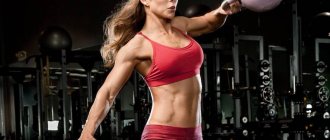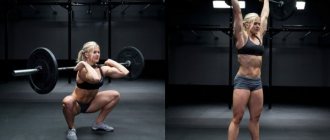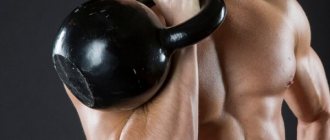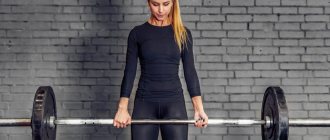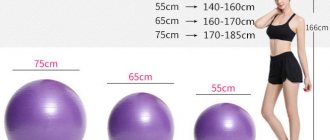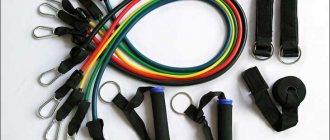January 19, 2022 Admin Home page » Interesting
Learn the basics of kettlebell lifting. Pros and cons of this direction. What muscles work? Rules of kettlebell lifting. Weight lifter's equipment. Interesting video.
It is unlikely that you will now meet people who are not known for kettlebell lifting or have not heard of it. Its history begins in the 40s. XIX century. For a long time it was considered exclusively male, but over time the fair half of humanity began to actively engage in it.
Features of kettlebell lifting
Kettlebell lifting is a sports discipline that involves performing a number of standards with a kettlebell (one or two kettlebells) for a certain period of time for a maximum number of repetitions. The entire list of exercises is performed while standing.
The total number of kettlebell lifting federations around the world is 56!
For men and women, the weight categories of the equipment differ, as do the requirements.
For example:
♦ for men in power biathlon the following weights are used: 16, 24 and 32 kg;
♦ for women and boys starting from the age of 11, a weight of 8 kg is used.
How to choose weight and number of repetitions
As a rule, women choose kettlebells with weights from 8 to 16 kilograms, and men - from 16 to 32.
To find your weight, try performing five repetitions of one exercise. If it's easy, take heavier weights. If you can't finish the exercise, you need less weight.
Once you find your weight, don't do all the exercises with it. Some of them you can do with heavier weights, while others will require lighter weights. Select the weight for each exercise separately.
As for the number of repetitions, aim for five sets of 10-15 reps. If you feel like you can do more, do it.
Benefits of kettlebell lifting
♦ develops strength endurance
♦ multi-repetition training improves coordination and speed qualities;
♦ the condition of not only muscle fibers and ligaments, but also the heart muscle improves;
♦ blood pressure is normalized, elasticity is improved and blood circulation increases;
♦ if the correct technique is followed, joint mobility is maintained and developed.
What muscles are trained?
When working with weights, complex muscle training occurs, namely: legs with buttocks, back and deltoid region. In addition, deep-lying muscles are subject to stress, which also work when performing static exercises.
Moreover, the strength of the buttocks, legs and back is much more important than the shoulders, because in order to perform a jerk, the power of these areas is necessary.
How to practice?
All exercises with a kettlebell for girls are based on 3-4 basic movements - swings, holding with two hands/palms, holding with one hand and the most difficult one - jerks.
In various exercises, you essentially use kettlebells in the same way as dumbbells/barbell/medicine ball, this will help you work the deep muscle fibers, which will give your body strength and your muscles a pronounced shape and attractive relief, as in the pictures. But what weight of kettlebell is right for you? Find out from the table below.
Kettlebell lifting rules
How many disciplines?
Mandatory rights include:
⇒ biathlon - snatch of one weight while changing hands without rest and push of two weights at the same time. It is in the female version that there is only a jerk;
⇒ power juggling – performed with 12-16 kg weights. for men and 8 kg. for the fair half of humanity.
How many reps?
Within 10 minutes you need to perform one of the disciplines for the maximum number of repetitions.
Exercises with kettlebells
Russian kettlebell swings
Russian kettlebell swings differ from regular ones in that the kettlebell is not raised above the head, but only slightly above the shoulders. If you are unfamiliar with this exercise, it is best to start with simple Russian swings.
Exercise technique
- Stand straight, place your feet slightly wider than your shoulders.
- Grasp the weight with both hands, lean forward slightly and place the weight between your legs.
- The back should remain straight.
- Swing the kettlebell, bringing it to shoulder level. The movement starts from the hips, not the arms, which provides the force of the push.
- Lower the weight down, bringing it back between your legs, and repeat the exercise.
Swing a kettlebell with one hand
This movement is similar to the previous one. The only difference is that you work with one hand.
One-arm swings allow you to better pump up target muscle groups and are suitable for those who have already mastered two-handed kettlebell swings.
Bent-over kettlebell row
This exercise helps to pump up your back well. It will be an excellent replacement for dumbbell rows. Due to the shifted center of gravity of the kettlebell, performing the exercise will be a little more difficult.
Exercise technique
- Take two weights and lean forward with your back straight and knees slightly bent.
- Pull the weights towards your stomach. At the final point, the handles of the weights should be located in the stomach area.
- Pull the weights with your back muscles, not your arms.
- Keep your elbows close to your body, do not spread them out to the sides.
- Lower the weights to the starting position and repeat.
Eight kettlebells
This exercise pumps up the core muscles well and also provides stress on the arms and legs. In addition, it looks quite impressive.
Exercise technique
- Stand with your feet wider than shoulder-width apart and hold the weight in your right hand.
- Bend your knees, lean forward slightly with a straight back and bring the weight between your legs at body level.
- Reach your left arm back and take the weight from your right hand.
- Move your left hand with the weight forward and move it back between your legs.
- Reach your right hand back and grab the weight from your left.
During this exercise, you seem to describe a figure eight around your legs, passing the weight from hand to hand. It may be difficult to coordinate the movements at first, but with a little practice you will get used to it.
Read also: Arm workout for women: 3 workouts to increase size and strength.
Due to inertia, the exercise is performed quite easily, so you can take a heavier weight. The main thing is not to slouch your back, otherwise it can have a bad effect on your lower back.
Deep squats with a kettlebell
This exercise will help target your legs and buttocks. By using weights in the form of a kettlebell, you will achieve the desired shape much faster than doing repetitions without weight.
Exercise technique
- Stand up straight, hold a weight in front of your chest with both hands.
- Keep your elbows close to your body.
- Keeping your back straight and your pelvis back, do a deep squat.
- At the bottom of the squat, the hip joint should be below the knees.
- Return to starting position and repeat.
Jump Squats
If you want to work your leg muscles more and improve your explosiveness, try adding a jump to your squats.
Exercise technique
- Stand straight, place your feet shoulder-width apart, hold the kettlebell at your outstretched arms below.
- Squat until your thighs are parallel to the floor or slightly less.
- Jump up from the squat and repeat.
- To make the exercise more difficult, you can place plates or step pads under your feet. This will help deepen your squats, increase your range of motion, and increase your load.
Lunges with kettlebell push
During lunges, the muscles of the legs and buttocks are worked, and lifting the weights provides stress on the shoulders and arms.
Exercise technique
- Stand up straight, hold the kettlebell in your bent arm at shoulder level, elbow close to your body, arm turned with your palm facing your body.
- Lunge forward and at the same time raise your arm with the kettlebell above your head.
- Return to the starting position, lowering your hand with the kettlebell as you lift.
- Repeat on the other leg.
Russian twist with kettlebell
The exercise perfectly loads the core muscles, but it is quite difficult to perform and has a number of contraindications.
It should not be performed by those who have poorly developed rectus abdominis muscles, a stiff thoracic spine, or have back problems.
Exercise technique
- Sit on the floor on your ischial tuberosities, press the weight to your body and hold it in both hands, do not place your elbows to the sides.
- Raise your legs off the floor with your knees bent.
- Try to keep your back straight.
- Turn your body to the right and left without rounding your back or lowering your legs.
Mill with weight
This exercise requires some flexibility and good hip mobility. It simultaneously stretches the latissimus dorsi and strengthens the muscles of the core, arms and shoulders.
Exercise technique
- Stand with your feet shoulder-width apart, grab a kettlebell in one hand and lift it above your head.
- Bend to the side as far as the stretch allows. Ideally, you should touch your foot with your hand. The weight remains in the outstretched hand at the top.
- Return to starting position and repeat.
Lying down one-arm kettlebell raises
This exercise will help you tone your pectoral muscles, arms, and core muscles.
Exercise technique
- Lie on your back, bend your knees and place your feet on the floor.
- Hold the kettlebell in a bent arm, the shoulder lies on the floor, the elbow is pressed to the body, the angle between the shoulder and forearm is 90 degrees. The palm is turned towards the body.
- Press the kettlebell upward, turning your elbow to the side and your wrist with your palm facing your feet. At the extreme point, the weight is located above the chin.
- Lower the weight to the starting position and repeat.
Swing the kettlebell around yourself
This is another fairly effective exercise that perfectly pumps up the muscles of the core and arms.
Read also: Training with kettlebells: 5X5 program.
Exercise technique
- Stand with your feet shoulder-width apart and hold a kettlebell in one hand.
- Bring the weight behind your back and grab it behind your back with your other hand.
- Bring your arm forward and grab the kettlebell with your other hand.
Kettlebell swings with side steps
This is a universal exercise that combines regular kettlebell swings with movement around the gym. Great cardio for those who are tired of the treadmill.
Exercise technique
- Perform a Russian kettlebell swing. When the weight is at the top point (chin level), place your right foot next to your left, connecting them together.
- As the kettlebell lowers from the top, step sideways with your left foot, placing your feet shoulder-width apart.
- When the weight passes between your legs and goes up again, place your right foot next to your left and connect them together.
- Repeat this exercise on one side and then the other. To go to the right, you need to put your left foot down during the swing, and when the weight goes down, step with your right foot.
Deadlift with kettlebell
This exercise perfectly pumps up the buttocks and hamstrings. The load also goes to the core muscles.
Exercise technique
- Stand straight, feet shoulder-width apart, holding a kettlebell in both hands.
- Tilt your torso, push your pelvis back and lower the kettlebell to the floor.
- Keep your back straight while bending.
- Return to the starting position, tensing your buttocks and abs.
- Repeat the exercise.
Lifting a kettlebell onto the shoulder
This is a fairly challenging exercise, so try it with light weights first and add pounds very carefully. When performed correctly, the exercise provides stress to the legs, buttocks and back.
Exercise technique
- Place the kettlebell between your legs, lean towards it with your back straight and grasp the kettlebell with one hand.
- Bring the kettlebell between your legs behind your body, gaining momentum, and then swing it up to shoulder level, turning your arm so that your palm is facing your body.
- The elbow should be close to the body, the wrist continues the line of the arm, without bending. The weight seems to hang on the indentation between the thumb and the rest of the fingers.
- Lower the weight so that it passes between your spread legs and bring it up again.
Standing two kettlebell press
This exercise will perfectly pump up the upper body: arms, back and shoulders. It also involves the core muscles.
Exercise technique
- Take two weights and throw them over your shoulders. The elbows are close to the body, the palms are directed towards each other.
- Press the weights upward, turning your palms forward so that at the top point the weights are located behind your hand.
- Lower the weights to the starting position at shoulder level and repeat the exercise.
One-arm kettlebell snatch
This is not only a strength exercise, but also a cardio workout. If you choose the right weight, the very first set will greatly raise your heart rate. In addition, the exercise pumps up the shoulders, chest and core muscles.
Exercise technique
- Stand with your feet slightly wider than shoulder-width apart and place the kettlebell on the floor between your legs.
- Lean towards the kettlebell with a straight back, moving your pelvis back, grab it with one hand, and move the other back behind your back.
- Bring the kettlebell between your legs, swinging it back a little, and then swing it forward.
- Snatch the weight, bringing it above your head. The palm faces forward, the weight is behind the hand.
- Lower the kettlebell down so that it passes back between your legs again, and then repeat the upward jerk.
Kettlebell plank + alternate rows with each arm
Try to complicate and diversify the plank with kettlebells. This exercise primarily develops the abs, and due to alternate lifting of weights, it puts stress on the arms and back.
Read also: How to perform a Z-press while sitting on the floor.
Exercise technique
- Get into a plank position with your hands on the handles of the weights.
- Raise one arm with the kettlebell.
- Try to keep your body straight while lifting the weights, do not rotate your hips. Ideally, the hips should be firmly fixed.
- Pull the weight with your back muscles, not your arms.
- Lower the kettlebell to the floor and raise your other arm.
Turkish get-up with kettlebell
This is a very interesting exercise. There is quite a lot of movement in it, so you will have to make a lot of effort to maintain your balance. With its help, you can provide stress to all the muscles of the body.
Exercise technique
- Lie on the floor with your arm extended above your head. If you are holding a kettlebell in your right hand, bend your right leg and place your foot on the floor.
- Raise your body, holding the kettlebell above your head, into a glute bridge. Lean on your right leg, straighten your left and extend it to the side.
- Place your left leg behind your right and place it on your knee. You will find yourself at the bottom of a lunge with the kettlebell overhead.
- Stand up from a lunge and place your feet shoulder-width apart.
- Return to the starting position, going through all the steps in reverse order: lunge, glute bridge, floor position with bent leg and kettlebell in outstretched arm.
- Repeat the exercise.
Kettlebell push-ups
This exercise works the same muscles as regular push-ups: chest, triceps, core. Due to the fact that the hands are not on the floor, but on the handles of the weights, the exercise becomes more difficult.
Exercise technique
- Stand in a prone position with your hands on the handles of the weights.
- Do a push-up, keeping your elbows close to your body.
- Try to tighten your abs and buttocks to keep your body straight.
Kettlebell push-up
This exercise combines the two previous ones, and therefore it is even more difficult and effective for pumping up the arms, back and chest.
Exercise technique
- Stand in a lying position, leaning on the handles of the weights.
- Do a push-up.
- Pull one arm with the kettlebell toward your waist. Keep your elbow close to your body and try to pull the weight with your back muscles.
- Place the hand with the weight on the floor and repeat the exercise with the other hand.
Equipment for kettlebell lifting
The right choice of equipment is not necessary for beauty, it reduces the likelihood of injury and helps make exercise easier.
♦ WEIGHTHEADS (SHOES) – borrowed from weightlifters. They fix the ankle, protecting it from dislocation, thanks to thick leather material and lacing along the entire length of the barbell. A heel of up to 2 cm is allowed.
♦ WEIGHTLIFTING BELT – should be leather-based, no more than 12 cm wide. Its main purpose is to fix the lumbar region in order to avoid deflection of the lower back and its injury.
♦ T-shirts and bicycle shorts – outerwear should be short-sleeved, 10 cm above the elbow. The lower part should also not cover the knees.
♦ BANDAGES – have an elastic base, used to avoid injury to the knee joints;
♦ Wristbands – secure the wrists, relieving pain. Usually their width does not exceed 10 cm.
Set of exercises:
Circle 1:
- Kettlebell swings - 30 seconds
- Elbow plank - 30 seconds
- Jump squat with legs switched (with body weight) - 30 seconds
Do it three times.
Circle 2:
- Squat with 3 second hold - 30 seconds
- Shwung press - 30 seconds
- Kettlebell throws - 30 seconds
Do it three times.
Circle 3:
- Kettlebell Clean - 30 seconds on the right side
- Side Lunge—30 seconds on the right side
- Rows - 30 seconds on the right side
- Kettlebell Clean - 30 seconds on the left side
- Side Lunge - 30 seconds on the left side
- Rows - 30 seconds on the left side
Do it twice.
Circle 4:
- Kettlebell arc overhead in kneeling position - 30 seconds
- Lunge “Around the World” – 30 seconds
- Walking hand push-ups - 30 seconds
Do it three times.
You can rest 30 seconds to 2 minutes between each circle.
